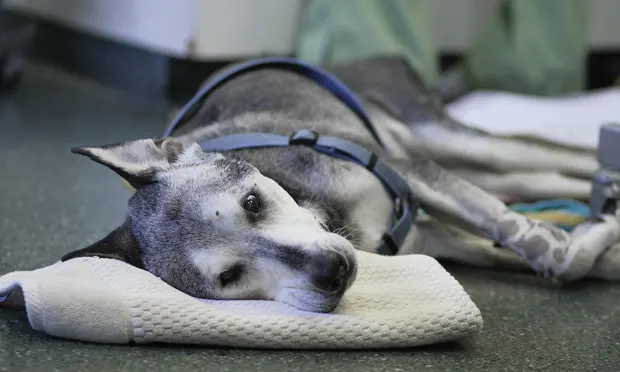How to Provide a Peaceful Death
Jen Brandt, PhD, LISW-S, The Ohio State University College of Veterinary Medicine

A version of this article originally appeared in the October 2014 issue of Veterinary Team Brief.
As a teen, I watched my pet Sam die from complications of renal failure—a painful and protracted death, on a weekend, in the middle of the night, without access to medical services. Sam’s death played a key role in my understanding of death and dying and reminded me that although death is inevitable, suffering need not be.
I have had the privilege of being present for hundreds of deaths throughout my veterinary career in emergency and critical care, hospice, palliative care, and social work. (And I do consider it a privilege.) I have learned that a natural death does not guarantee a good death, and that there is no universal blueprint for discussing death that ensures all parties will be comfortable with the topic. The following are lessons learned through personal experience and from patients, clients, and veterinary professionals.
1. Euthanasia: A Good Death
The word “euthanasia” comes from the Greek “eu,” meaning goodly or well, and “thanatos,” meaning death, and literally means “good death.”1 Providing a good death for a patient is not “quitting”—it is an essential treatment option.
Providing a good death is an essential treatment option.
Consider the way your client hears, We can continue to do all we can medically, or we can stop treatment and euthanize, versus the way the same client hears, We always want to offer our patients the best medical care available. In Joey’s case, the best treatment we can offer and you can choose for him is euthanasia, which will allow him to die in peace and end his suffering.
2. Death Is Not Optional
Talking about it isn't, either. Some veterinary professionals effectively normalize the topic of death with clients in a pet’s early years, setting the stage for more in-depth conversations later. For example: We are here to help provide the best care for Joey throughout his lifetime, including recommended vaccinations, exercise, nutrition, and wellness plans. We’ll also talk about how to maximize his health for as long as we can, and the benefits of euthanasia and end-of-life care planning when a healthy life is no longer possible.
When a client elects a natural or unassisted death for his or her pet, you should educate the client regarding the signs that may indicate the pet is dying. For example, say, In some instances, a pet may die in his sleep, and it may be difficult to notice the transition from living to dying. In other instances, you may see signs such as head stretching, paddling, and even seizures that may indicate your pet is in the final stages of dying.
3. Speak Clearly
Initiate an explicit conversation when euthanasia is the best medical treatment. We do not expect clients to formulate a list of differentials and treatment options in any other situation—that is our job. The same is true when euthanasia is a patient’s best option. The conversation can start with a simple open-ended question such as, What are your thoughts about euthanasia?
4. Start the Euthanasia Conversation Early, Not Late
There is no magical time to advise clients that a good death is the best medical treatment for their pet. However, when circumstances allow, talk about death, dying, and euthanasia before a patient is suffering.
Having time to process their pet’s medical realities before a crisis allows clients to balance their reasoning and emotions during decision-making.
I have been with many clients whose hearts were not ready to accept what their brains knew. Having time to process their pet’s medical realities before a crisis allows clients to balance their reasoning and emotions during decision-making. Consider saying, At some point, Joey will die from this illness. As veterinarians and owners, we have certain signs we can look for to learn when pets are suffering. You know Joey better than anyone. What are some of the signs that would indicate that Joey is having more bad days than good days?
5. Embrace Discomfort
Some clients may react strongly to references of “death,” “dying,” and “euthanasia.” However, their strong reaction means they are hearing, and are affected by, what you are saying. This is a healthy, appropriate reaction in most cases. Have the conversation, knowing that it may be uncomfortable: I know that euthanasia is difficult to talk about. Tell me more about what you are thinking.
Conclusion: The Veterinary Oath
Euthanasia is an emotionally charged topic for both veterinarians and clients. The key difference is that veterinarians take an oath and have the privilege of relieving patients’ pain and suffering. We are charged with advising clients that providing a peaceful death may be as essential to responsible ownership as all other aspects of a patient’s medical care.